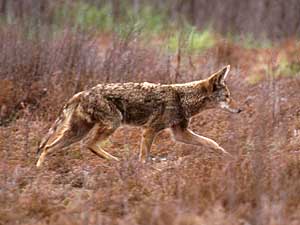|
Photos
Resources
|
February 13, 2005
The number of coyotes living in Minnesota is on the rise, and so are the number of coyote sightings. So some lawmakers are proposing to bring back bounties on coyotes. Members of the House Environment and Natural Resources Committee unanimously approved a bill recently to allow bounties. The legislation would give county commissioners the authority to put a pricetag on coyotes.
Moorhead, Minn. — Swift County Commissioner John Baker says in his neighborhood, coyotes are a real problem.
"I've been getting calls from citizens in my district," says Baker. "One just called the other day. (Coyotes) killed his German shepherd. We've got some cattle that have been run out of corrals, and every spring we lose calves."
Baker woke up one morning to find a coyote staring at him, five feet outside his bedroom window. Coyotes aren't usually that bold around humans. Baker says if the animal is losing its fear of humans, it's an indication something must be done. Baker thinks giving counties the power to set a small bounty of $10 or $20 will encourage hunters to kill the animals.
"For a county to be allowed to set a small incentive ... and surrounding counties around here will probably go together -- we're not the only county that's noticed a problem with them -- and do it by the year and see what comes in. If there's been a number of them taken, you probably take it off (the bounty) for two years or three years," says Baker.
Counties would have to raise the bounty money. Despite the bill's appeal in many rural areas, it has detractors, including the Department of Natural Resources. DNR spokesman Conrad Christiansen says Minnesota eliminated its bounty programs almost 40 years ago because they didn't work.
"That's been the experience just about everywhere in the country," says Christiansen. "Bounties don't get at individual problem makers."
Christiansen says since coyotes are not an endangered species, there is already an open season on them. They can be shot or trapped year round. Despite this, populations of the animal are on the increase in some areas.
"If you've got a stockman out there and he's got coyotes in his pens or near his pens, he's got an obligation to take care of the problem himself," says Christiansen.
The bounty legislation has flown under the radar of national animal rights groups, such as People for the Ethical Treatment of Animals, known as PETA. PETA spokeswoman Stephanie Boyles says her group opposes bounties. According to Boyles, the state of Virginia enacted legislation similar to the bill being proposed in Minnesota. She says it hasn't worked.
"We have more coyotes now than we did when they established the bounty. These animals reproduce at an incredible rate," says Boyles. "And thinking that you're going to solve problems with them by attempting to reduce the number of the animals, through trapping or shooting or any other lethal means, is a real waste of time and money."
Despite those questions, support for the legislation appears to be strong at the Capitol. The bill gained unanimous approval last week in a House committee. Rep. Aaron Peterson, DFL-Madison, chief sponsor of the bill, is confident it will pass.
"If the group that is co-sponsoring the bill already recruits, and we are successful in communicating to the whole body, I think we'll be able to get 68 votes in the House, because I've already got 35 co-sponsors," says Peterson.
The bill would also need approval by the Senate before going to the governor for his signature. The bounty proposal will get a hearing in a Senate committee on Monday.





